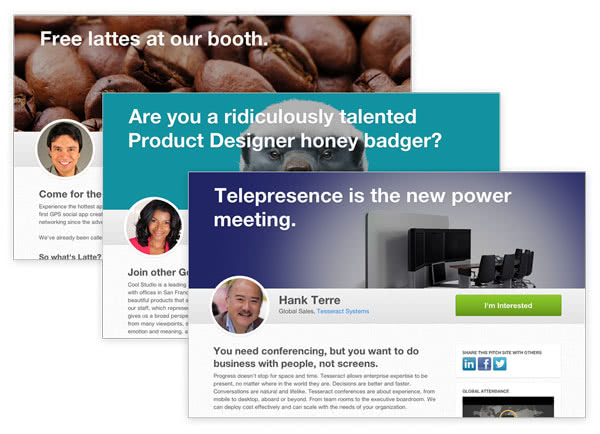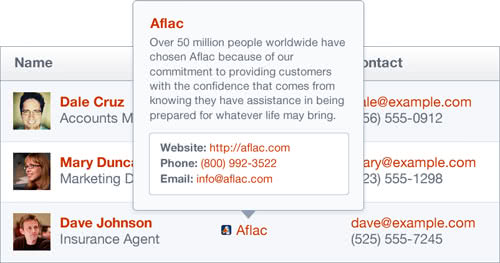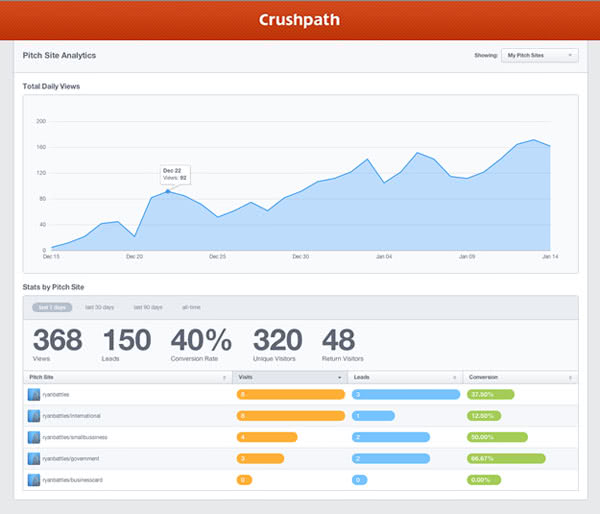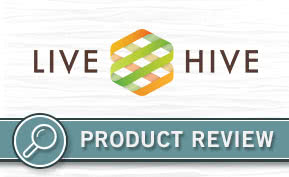Sales Tools
Social CRM
Web Content Management
Let's Talk Crushpath: Behind the Software with CEO Sam Lawrence

No matter who you are, chances are you’ve had to pitch an idea, product, or service to someone. But up until now, if you didn’t have access to a CRM, your selling tools were pretty limited. Crushpath is bringing cutting edge sales tools to the masses. With a second round infusion of $6 million and the launch of a great new pitch site feature, Crushpath is poised to revolutionize the sales world for everyone. We talked to CEO Sam Lawrence and SVP of Product Matt Wilkinson, and learned more about what’s on the horizon for this innovative young company.
Tell me a bit about Crushpath. What do you do, and where are you right now?
At the top level, Crushpath is the new way to pitch anything. What we do is we allow anyone–salesperson or not–a really simple easy way to pitch, get responses and build relationships. In the same way that Square brought the ability for anyone to take a credit card, not just stores, we bring the ability for everyone to sell, not just salespeople. 10% of the population is salespeople, but the other 90% are part of what we call “sometimes salespeople,” who are folks like us, where bringing new business is a part of our job. People like consultants, entrepreneurs, recruiters, and agents spend a huge part of their day pitching; but they have to use cold calls or emails. There’s really nothing that helps them pitch and build relationships.
Right now we’re announcing the launch of what we call pitch sites, as well as our second round of $6 million funding. That’s led by Social Capital with participation from Charles River Ventures. It follows a $2 million seed round, which we announced about six months ago, led by Charles River Ventures.
What was your background was before you came to Crushpath, and what was the inspiration behind starting the company?
As far as background, Matt and I both worked at social enterprise companies. I was the founding CMO for Jive, and they IPO’d back in December of 2011. Matt led product for a company called Social Cast, which was sold to VMWare. We met up through that process actually; the companies knew each other and we knew of each other and were fans of each other’s work.
The idea for Crushpath actually started after one day where I bombed trying to pitch Jive to a client over at Sony Playstation. Then the same day, later on, I suffered through the receiving side of a phone call from a CPA, who was trying to pitch me for my tax business. I realized that salesperson or not, pitching is just very painful on both sides. It really got Matt and I thinking, “what about those ‘sometimes salespeople’?” We started taking a look at the fact that we’re still using emails or cold calls. Were we really supposed to use something as complex as a CRM that was made for professional salespeople? When we looked around the market, it was like 1988 called and they wanted their sales tools back.

So you were looking to bridge the gap between the all-out sales tools and the very, very entry level basic stuff?
First of all, it struck me that there are a lot more people playing sales roles than salespeople; secondly, that the industry had over-invested in a bunch of extremely complex, boring sales automation databases, but really none of it helped us sell ourselves. The third thing is that everyone’s using the same stuff. We’re all using email and cold calls, with standardized profiles on LinkedIn, and there’s no way to stand out.
In a world full of tweets and links and ADHD, the need to cut to the chase has really never been bigger than it is right now. That’s why eight months ago, Matt and I launched Crushpath as a way to keep track of new business relationships. It was a huge effort and it took a lot of time to get out in the market. We knew that we hadn’t yet launched a prequel of that, which is the pitch part. So that’s what we’re doing now, providing a way for anyone to get out there and drum up business before they get to the point of needing to manage the relationship.
Who’s the ideal customer for you? It sounds like you’re not looking to reinvent the wheel for salespeople, but maybe the rest of us. Are you aimed at big companies, small companies, or someone in between?
We actually have a pretty different model. We go after individuals; instead of corporate licenses, we go after winning the hearts and minds of individuals. Today, you’ve got to get that right before you even talk to somebody at the company level. So that means people who are in business for themselves, but also individuals at companies, too.
About half of our customer base is individuals, the folks we talked about- the tax guy, a real estate guy, somebody who does consulting. And then there’s the folks who work on pretty big teams, but they start at the individual level as well. That’s what we care most about right now. We care about nailing that before we start thinking about companies. That said, we do have folks like Cox, TriNet, McAfee, Beach Body, and State Farm. So we’ve got the big name folks, as well as a bunch of individuals across the gamut from the Fortune 500-level to the individual, with people at over at 5000 companies using Crushpath.
I think it’s great that you’re focusing on individuals, because it’s impossible to get people to use software if they don’t like it to start with. No matter how useful it might be, if you can’t get them on board at the beginning, they’re just going to let it sit on their desktop.
In our personal life, it has to work for us for us to use it, right? In an era of bring your own device and the consumerization of IT, if you go into companies, they’ve paid millions and millions of dollars for stuff that’s shelfware, but they know that the world has changed that way and they want to know that folks love it before they buy it for the company.
Speaking of bring your own device, mobile optimization is such a huge thing now; is that something that Crushpath has had to address specifically?
We actually started as a mobile app, and built the mobile solution before thinking about any other device. That was a good forcing function to keep things super-simple, as well as accessible. Whether it’s mobile and you’re on an iPad or you’re on your computer, Crushpath just has to keep things moving no matter what device you’re using.
Is there a steep learning curve for creating a pitch site, or is Crushpath something you can pretty much jump right into and get started?
It’s easy to just get in there and build a pitch site. It’s pretty amazing, sexy piece of software. It combines the idea of a content management system, which just helps you with content, and something that actually helps you create a pitch. As you’re editing in the page, you can see your edits happen real time. You get to pick your own URL, and use your own images, videos, stats, pitch, and offer. You can customize it, turn sections on and off, make it completely yours, and then publish it.
Here’s what’s interesting about how it helps you get response: we get a lot is people coming in and starting with their umbrella pitch, basically the general pitch that they would use all the time. Then what we see is just about everybody then goes on and creates some specific pitches for an offer or an audience that they want to target. You can make these public or private–there may be some that you want open to the world, but there may be a company or a client that you’re going after that you want to give a tailored piece of information or message, so that it’s more of a one-on-one approach.
There are three major ways that you actually can get responses from pitch sites. The first way, believe it or not, is that these sites become part of an identity for people–LinkedIn’s your resume and Facebook’s your personal life, but there really isn’t an identity for you, plus the thing you’re offering in the market right now. So people take the unique Crushpath URL, and they put it everywhere that their identity is. That includes not just the social networks, like Facebook, LinkedIn and Twitter, but also in their email signature. One of our most successful customers includes a link in his email signature. In just a couple of months, he got 3500 responses with just that. It really underscores how people want to consume things on their own terms, versus being on a phone or reading through a long email. So it was a surprise to us, but it makes a whole lot of sense.
The second way is in a targeted way. You can import your contacts, and then send specific pitches to specific contacts via email. It’s not a regular old email that they get, but a media-rich email with a thumbnail of the actual site that they’re going to see. When they see that, they respond. There’s a 75% response rate just from getting those kinds of messages out. They’re not a long blabbering email and they’re not a marketing form that everybody gets. It’s something that’s more tailored. That’s very, very effective for our customers.
The third way that folks use it is that they use it through their social network, to just spread the word in a ripple-effect way. When you publish, you can actually broadcast it automatically through your network–LinkedIn, Facebook, Twitter with a click. When other people interact with it, it’s exposed to those people’s network. It’s just a simple, easy way to raise that awareness and get referral-type responses.
What are the biggest challenges that maybe you’re not looking forward to, especially with this new funding and new product?
What we see with any new medium, just like when radio came out, or TV came out, or the web came out, or even when social media came out, is that there are two different kinds of companies. There are companies and individuals that look at this and they go, you know, holy crap, this is going to be a problem for us. If you remember when email started, people were freaking out. Like, you can just send a message and an attachment to somebody else? There’s always the kind of freak-out population. That’s one kind of company and one kind of individual that’s going to respond to this. They’re the naysayer kind of population, where they want control. They’re worried about other people at the individual level reaching out into the market, or doing something that’s going to hurt the company.
The other ones are the people who are a little bit more on the innovation front, and they look at new things and they go, “holy crap, this is awesome. Let me jump on this and use this in order to get an edge and get some competitive advantage. So, we anticipate both in 2013, and that’s fine. We’re used to that as people who’ve lived through that before at our last companies and in other companies as well, too. Whenever you’re the leader, you get those two different kinds of responses.
Hopefully most of the people that you encounter are going to be in that the second group, sorry, where they’re excited about it. Is there anything else you want to tell our readers; anything that they should know before they launch into your product?
I feel like anything that’s even close to sales software has the box of automation and machinery, filtration and frustration. The science part of sales has all been done; it’s been 30 years of the same stuff of contact management and databases and all that. If you believe that convincing others is one part science and one part art, then you’ll like that we’re really kind of going at it from the latter half.
We believe sales is beautiful, that moving people, motivating people, and convincing people is really what makes business happen. If we can reach out to folks and embrace the larger market of everyone who does that, then we can really make a big impact on the world.
Check out the rest of Crushpath’s great features and get started making your own free pitch site today at Crushpath.com








